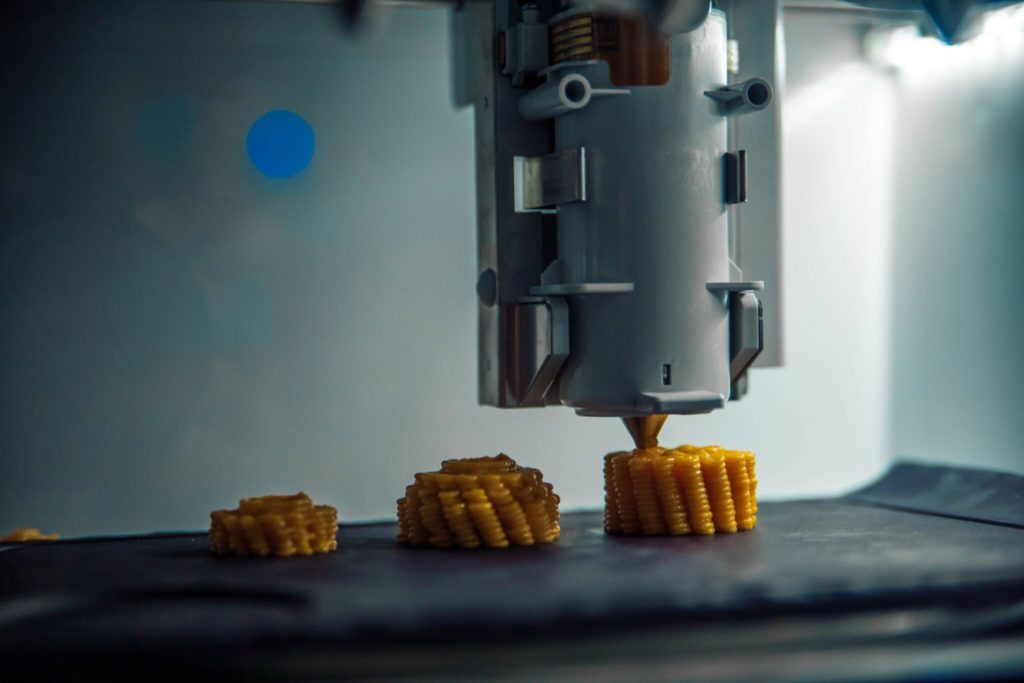Since its invention in the 1980s, 3D printing technology has evolved at lightning speed. A decade ago, the original technology — where physical objects are printed from 3D digital models — was only reserved for corporations and universities designing prototypes and architectural models. Today, smaller and more affordable, they can be easily seen in kitchens and storefronts, grade schools and homes.
3D food printing has found itself at the forefront of digitally printed objects. Currently, confectioneries around the world are using 3D printers to produce vibrant layers of candy. The culinary world is also using the technology to produce masterful desserts. Some entrepreneurs have gone further and opened restaurants that use 3D food printers to serve gourmet cuisines, such as Food Ink. Recent advancements in the 3D printing industry have also made it possible for these machines not only to print, but to also cook and then serve foods.
Food 3D printing represents a unique opportunity to go beyond aesthetic and tackle transformational change across economies, industries, global issues. Printers could create nutrient-rich and environmentally-friendly food products and even help address hunger problems in areas that need access to quality and affordable ingredients. The technology also creates an opportunity for food customization.
The Basic Principles
Current 3D food printers are designed to deposit small layers of material through a process called additive manufacturing — think of a frosting dispenser except the ingredients are squeezed out, layer by layer, by a robotic arm.
The latest models of 3D food printers are more complex and detailed. Examples of such devices are those used in the candy and baking industries. The 3D printer ChefJet crystallizes small layers of sugar into several geometric configurations, while Choc-Edge dispenses chocolate from syringes into intricate, delectable designs. Some advanced printers, such as The Foodini, use fresh ingredients filled in stainless steel containers to make different types of foods like stuffed pasta, pizza, brownies, and quiche.
Suffice it to say, 3D food printing technology is still developing and may hit new strides that will change food and the way people eat. But what does the future hold for 3D food printing? Will 3D food printers impact the food industry?
The Future: Customization and Health Impact
3D food printing is braced to have a big impact on the food industry. According to a 2018 Research Nester report, the 3D food printing market is expected to to expand at a compound annual growth rate of 50 percent during the period 2017-2024, and is expected to reach $400 million by 2024. The research suggests that the market growth is driven by two main factors: an increased desire for customization and applications from the healthcare sector.
Food industry places are making rapid advances with 3D food printing to ensure individuals and manufacturers can customize food products with regards to nutritional value, flavor, and ingredients. For example, consumers can tailor 3D printed food to their health requirement and taste. With this technology, it is possible to customize food for pregnant women, athletes, children, the elderly — people who commonly have very specific requirements in terms of nutrients. These devices can help people combine the right quantity of carbohydrates, fatty acids, minerals, vitamins, and other nutrients, helping consumers tailor food specifically to their individual dietary needs.
3D food printers can also allow for better control over portion sizes, cutting down on overconsumption and food waste. Moreover, they will have the capacity to turn raw ingredients into a healthy puree, making it easier for people with certain medical conditions who find eating whole foods challenging. German nursing homes are already using 3D food printers to make a pureed food product called “smoothfoods,” a mixture of fresh ingredients made into healthy, delicious molds that resemble their favorite dishes. This process allows the residents to enjoy food without fear of choking, discomfort or pain. There is also WASP, a 3D printing company in Italy, which is producing gluten-free products of popular foods, such as pastries in the shape of gnomes.
The Challenges
Despite the many exciting possibilities of 3D food printing technology, the industry still has challenges to overcome. To print food using the current 3D printer, users must convert their ingredients into a paste. It is the only way the device can manipulate the ingredients. Furthermore, most printers available today are designed for dry and shelf-stable materials, excluding most dairy and protein products that spoil faster. That means every ingredient must be dry otherwise users will have to worry that something could spoil. It is a matter of food safety. And while there is hype about 3D printed food and the technology in general, it is important to measure expectations. In simple terms, we must continue to consider the health, environmental and social impacts of food printing.
The 3D printing examples may seem anecdotal or out of reach, but expect to see more mainstream application of this technology in the future. 3D food printing is more than a fleeting curiosity, it’s a powerful tool that can forever change the way we make, choose and eat food.
